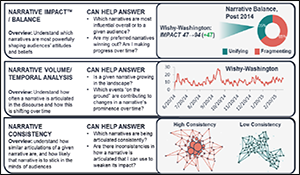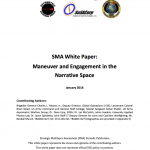Maneuver and Engagement in the Narrative Space

Maneuver and Engagement in the Narrative Space.
Author | Editor: Munch, R. (TRADOC G-27 TBOC).
The paper leverages and melds the latest thinking of academic and operational subject matter experts in fields of organizational and social dynamics, network analysis, psychology, information operations and narrative development, social media analysis, and doctrine development related to aspects of maneuver and engagement in the narrative space.
This paper was produced in support of the Strategic Multi-layer Assessment (SMA) of the Islamic State of Iraq and the Levant (ISIL) led by Joint Staff J39 in support of the Special Operations Command Central (SOCCENT). The paper leverages and melds the latest thinking of academic and operational subject matter experts in fields of organizational and social dynamics, network analysis, psychology, information operations and narrative development, social media analysis, and doctrine development related to aspects of maneuver and engagement in the narrative space.
The authors emphasize the concept of countering ISIL in the narrative space in synchronization with combat operations. While maneuver and engagement in the narrative space could be conducted independently of combat operations, conducting maneuver and engagement in the narrative space in support of combat operations is more likely to achieve lasting effects in the human domain. These ideas reflect a new view of what is required to succeed in future conflict because of the growing realization that decisive effects are often achieved in the narrative space.
The concept of maneuver and engagement in the narrative space belongs under the broader US Army Functional Concept for Engagement.i Narrative is one of the key elements of engagement, which is defined as,
…the capabilities and skills necessary to work with host nations, regional partners, and indigenous populations in a culturally attuned manner that allows bridging language barriers, bridging lines of communication and connections with key political and military leaders in a way that is both immediate and lasting.
As stated by Master Sergeant Sohail Shaikh of the US Army’s Asymmetric Warfare Group, “…narrative must be harnessed by the warfighter to reach friendly, opposition, and neutral populations in ways that might not otherwise be possible.” The capability for warfighters to use narratives and counter-narratives to reach and influence friendly, threat, and neutral elements of the human domain will be a critical capability for successful engagement during future conflicts.
Contributing Authors
Moore, C, (Global Operations, J-39), Steed, B. (US Army Command and General Staff College), Shaikh, S. (US Army Asymmetric Warfare Group) Eyre, D. (System of Systems Analysis Corps) McCulloh, I. (Johns Hopkins University Applied Physics Lab), Spitaletta, J. (Joint Staff J7), Munch, R. (TRADOC G27), Worret, C. (TRADOC G2)

Comments